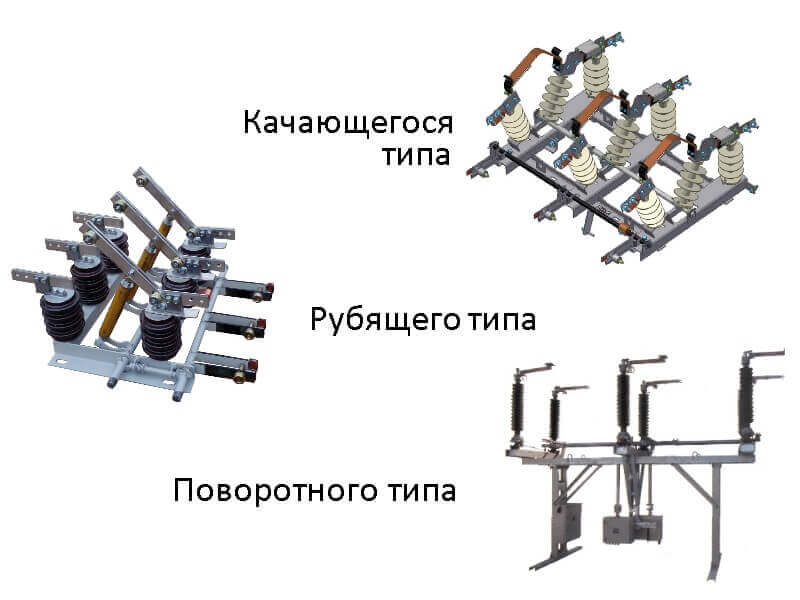What are high-voltage disconnectors for and what types of they are
Purpose and scope
A high-voltage disconnector is a switching device that allows you to disconnect a line with a visible gap. The need to create a visible gap is due to the fact that when using vacuum, oil or gas switches, it is not always possible to make sure that the contacts are completely disconnected, since they are usually located in a tank with an extinguishing medium (oil, gas, vacuum).
In the event of malfunctions of the high-voltage circuit breakers, it may happen that two phases are disconnected, and the third is not, or in another configuration, the circuit remains energized. In the future, when carrying out repairs or maintenance of power lines, workers will come under voltage.
Therefore, a disconnector is placed in series with the switch. If you describe it in simple words, then a high-voltage disconnector is a large circuit breaker whose device creates an open circuit of a high voltage. Where are such devices used?
High-voltage disconnectors are used everywhere on power lines from low and medium voltage, for example, 6 or 10 kV, to lines with a high of 750 kV.
In addition to disconnecting lines with a visible gap, BP is also used for switching:
- transformer neutrals;
- grounding reactors (if there is no short circuit to ground);
- magnetizing current transformers from 6 to 500 kV;
- charging current of air and cable power lines, bus systems and the like;
- ring currents (6-10 kV network).
It is also allowed to switch 10 kV circuits with a current of up to 15 A, as well as remotely disconnect one of the 220 kV disconnectors and more if it is shunted by at least one more disconnector. For example, when using a quadrangle scheme on a PS.
Main types
To begin, consider what classification of high-voltage disconnectors exists:
- According to the characteristics (rated voltage, current);
- By location (external and internal);
- By design.
Structurally, they can also differ:
- By the number of poles;
- By the movement of the knife (rotary, swinging, chopping type);
- By type of drive (operational dielectric rod, lever system, using electricity, pneumatics and hydraulics).
Device and principle of operation
High-voltage disconnectors do not have the means to extinguish the arc, so when disconnected under load arc may cause interphase short circuit.
In the figure below, you see a high-voltage disconnector with a lever drive.
Pay attention to the two drives in the figure - one for disconnecting the knives on the line, and the other for controlling the grounding knives (top). In some cases, two levers are combined in one drive - one for grounding and one for power. At the same time, they are switched on in different directions so that their simultaneous inclusion is excluded, such as a PRNZ, which is shown below. It is mounted on a support below and is connected via dielectric traction to the disconnector knives.
In the video below, you see how the disconnector on the 735 kV transmission line works for breaking, pay attention to how strong the arc is.
High-voltage disconnectors for outdoor installation should be more durable and withstand heavy mechanical loads. For example, when opening in case of icing, in the figure below you see such a device on a 6 kV support, also you see traction from below from the manual drive.
To control the electric drive of the disconnector, control cabinets are used, they are placed on the ground, large forces are required for switching large devices, therefore, one such cabinet is installed on each pole (phase).
So how is the high voltage disconnector designed? If we answer this question in a generalized way, then it consists of:
- Frames.
- Insulators.
- Contact knives.
- Drive.
The video below illustrates the design of the disconnector:
The device may vary depending on the type of disconnector.
Before you do the switch
Switching is done only after receiving the appropriate order. First, they check whether the circuit breaker is open in this circuit, then conduct an external examination of the insulators for cracks and chips - if they are, they do not perform operations.
Also check the status of locking devices and drives. In case of visible damage, if possible, act on the drives carefully and with the permission of the person who issued the order. Jumpers and bypass switching devices should also not be.
When using a manual drive, the disconnectors include fast and confident movement, but without impact. If an arc arises when current-carrying parts are approaching, they will not be retracted to avoid elongation and overlapping of neighboring phases. When the contacts are completely closed, the arc disappears. Switch off in slow motion, without jerking. The first movement is a trial, to check the integrity of the rods. After that, the circuit is opened, if at the same time an arc arises - it is quickly switched back on, and until the time of clarification of the reasons for its formation is produced.
That's all we wanted to tell you about high voltage disconnectors. Now you know the main types and types of these devices, what they are intended for and where they are used. We hope the information provided was useful and interesting for you!
Surely you do not know:














